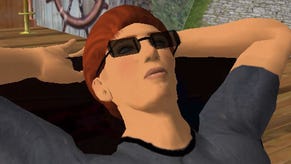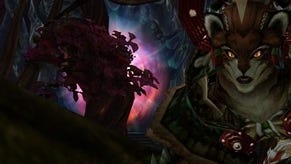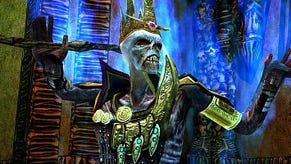Second Life at ten: a decade of expression - part one
Second Life turned ten this month. VG247's Dave Cook explores the legacy and misconceptions of Linden Lab's virtual world, and asks long-time residents why they've lived there so long.
Linden Lab launched Second Life on June 23, 2003 and within months it became a phenomenon among the tech and gaming press.
It's now over ten years later and Second Life is scarcely reported by the media.
Back then you couldn't go a week without reading reports that attempted to summarise what it was, how it worked, or the ways in which it impacted the daily lives of its inhabitants. Said reports were frequently inaccurate however.
Here was a virtual plane of existence that offered a fully-functioning economy, the right to free speech within the confines of social decency and an unprecedented degree of escapism. It was hard to fathom.
The freedom on offer scared and excited people in equal measure and no matter how hard journalists tried to summarise it, the world was difficult to understand at arm's length.
You had to actually take up residency in the world over time to fully appreciate its allure, but even then it existed as a complex melting pot of ideals and motivation.
It played home to people who each had their own unique reasons to carve out a digital persona and live it with conviction, and it was this malleable appeal that spoke to residents on a personal level, and helped them extend their social reach in new ways.
Some viewed it as a means of escaping the mediocrity of the daily grind, others used it as a virtual meeting place for business discussion, while other reasons went much, much deeper. It is whatever you want it to be, and that is an incredibly powerful selling point indeed.
People are still living out second lives in the world today, and many of them have been doing so for several dedicated years. Today's MMOs may have embraced ideals first coined by Linden Lab's world, but there's no denying the company was a pioneer in its day.
I found the prospect of denizens still committing to their alternate realities after such a long span of time fascinating, so I decided to approach the community with a view to better understanding the appeal of Second Life.
Approaching the Second Life community
The pitch was simple: Back in January I had planned to take up residency in Second Life for three months. I hoped that I'd have enough experience to properly summarise the world in a fair and accurate light in time for its tenth anniversary. However, the idea was quickly shot down by users. They told me it couldn't be done.
Much of the resident's scepticism came from the fact that gaming journalists had approached them before with the same concept, and they told me about how writers came bearing the most common misconception of all; that Second Life is a game.
I made the same mistake and was quickly met with a wall of rebuttal, as people who live within Second Life largely view themselves as 'residents' or 'users' instead of players. To them Second Life it isn't something you play, it's something you live and many of the world's inhabitants regard their digital avatar as a true extension of themselves.
”[Linden Lab] is in a tough position. They’re the giant in the playground. As the operators of Second Life, and the developer of its core infrastructure, they’re in a difficult position where changing anything will disrupt someone.”
There was no malice in their objection but the residents told me they had been grossly misrepresented in the press before as addicts, shut-ins or worse, and they were fearful that history would repeat itself if I ventured any further. I was keen to avoid painting a false image of these people and their world so I kept on talking with them.
Several barriers were torn down between us over time and eventually I was able to speak more openly with some of the residents. It enabled me to clear the air on several thorny issues. For one, many of Second Life's resident's have little love for Linden Lab, the same company that gave birth to the world they had been living in for years.
One resident known as Tateru told me that the company is in a precarious place. On one hand Linden Lab is the creator of Second Life, while on the other, any significant changes it makes to the world will undoubtedly have an impact on those living in it. As such the company has to be wary of such consequences.
Perhaps one of the most prolific stories from within Second Life was the developer's introduction of tax on residents who created a large flow of in-world content. Dubbed 'Linden Tax' by residents, the policy had a knock-on impact on real currency flowing through the world, which triggered mass protests among residents.
You can find a superb overview of the revolt here. It showed that while Linden Lab governed the world, it had to be wary of how even the slightest change might impact the lives of residents.
Tateru shared some insight into Linden Lab's role in such changes, “They’re in a tough position. They’re the giant in the playground. As the operators of Second Life, and the developer of its core infrastructure, they’re in a difficult position where changing anything will disrupt someone - perhaps hundreds or thousands of people - and doing nothing is perhaps even worse.
“While it is staffed by a larger bag of competent, brilliant and caring people than you generally get gathered altogether in one place, the company itself projects an air of obscurity, secrecy, and capriciousness – as if it is about to pull on a Halloween mask and jump out of the bushes at any moment armed with a new policy or feature change that will upset someone.”
The balance between respect and distrust for Linden Lab changed depending on which resident I spoke with, but the prospect of writing one article to do all of these conflicting ideals, themes and facets justice quickly made my head spin. Some residents went so far as to suggest I ditch the idea altogether and re-work the concept.
After weeks of racking my brain for a solution I took their advice and decided to take up residency in Second Life for a short while, but rather than write an article with an authoritative air – where I acted as if I knew everything about the world – I would approach it with fresh eyes as a complete newcomer.
That way I could give readers a base-line view on the world, an insight on how it worked from a practical standpoint and to clarify several falsehoods surrounding what it means to be a resident. These people aren't sad shut-ins; they're smart, interesting people with great stories to tell – both real and virtual, so I managed to pin down three of them to guide me in my quest for the truth.
You 2.0
Dillon describes herself as 'transgendered'. She has been a Second Life resident since September 2008 and lives in the world as a female because she has no desire to physically alter her appearance in real life for fear of upsetting her family. In Linden's world she can enter a persona in which she feels most comfortable without fear of backlash or ridicule.
“The friends that I've made, the minds I've met, and the experiences we've shared are all reasons I stay,” Dillon explained. “I was thinking about this today. We travel through Second Life and meet people. Sometimes we connect with the people we meet, for the same reasons we 'connect' with people we meet in real life. We enjoy each other's company.
“My best friend is a DJ. She had a gig last night. She's from the East Coast of the US. Her girlfriend, who lives somewhere in Canada, was there as well. I live in California. A friend from New Zealand was there. My point is that Second Life lets us find and connect with all these people from all over.
“One of the things that strikes me the most is the way Second Life promotes tolerance of the different. In my particular case that’s demonstrated by the fact that I can – and do – have perfectly normal conversations and in some cases friendships with totally heterosexual males.”
“I personally am limited by my lack of language skills: English is all I can do. My multilingual friends can go even farther. The end result is that we establish friendships here with people from all over the world, and Second Life lets us truly share experiences. We can see the same things, hear the same music, and enjoy the ambience together. There's no way most of us could to that in real life.”
Dillon's depiction of a virtual plane full of collaboration and discussion is heart-warming and from the moment I first went in-world it became clear that Second Life truly was a social place. It certainly wasn't a game either, as there was no scoring mechanic, no missions to be completed and no narrative to speak of.
It was just me against the world and it was up to me to decide how I was going to tackle it, but that in itself proved intimidating. As I wandered through plazas and parks the residents became increasingly noticeable by their absence, aside from the occasional person running around with purpose and a group of idle avatars chatting with each other by the area's entry point.
The area certainly wasn't how I imagined Second Life to be at the peak of its popularity. Instead I headed to an interesting steampunk world based on Victorian architecture which was full of grand halls and lush gardens just begging to be explored. Whoever built it was clearly well versed in design and programming.
As I strolled listlessly past detailed paintings hanging on the walls, delicate harp strings could be heard strumming on the breeze. It was relaxing, like a true moment of respite from the chaos and noise of the real world and my dreaded email inbox. It still felt largely abandoned however, so I then travelled to an adjoined airship world with a runway where residents could test-fly a variety of aircraft.
The vessel was lined with anti-air guns that I guessed had long fallen silent, and I started to feel slightly alone as the only person in the area. I began to stroll through areas with item vending machines crafted years ago and stores with no one in them, and I thought about the discussions people might have had one day, or the friendships they might have sparked in passing.
Tateru later explained that space is actually a key tenet of Second Life and that areas that may seem vast and empty are often that way by design, as to avoid crowding. There's also an economical effect that sees market vendors spread out to avoid overcrowding and users jostling for sales in close proximity. It is not a loud, manic digital bazaar by any means.
While my first hours in Second Life were relatively lonely, that isn't to say I didn't encounter anyone during my time in-world. I had to ask a few people how to pull off basic functions like downloading free clothing samples from a store that had Queen's 'Another One Bites the Dust' blasting out the front, and then I had to ask someone else how to dress my avatar properly. It's not an easy world to adjust to, but you learn by doing just like in real life.
“I was still fumbling along in the first few hours, exploring and learning, and ran into another pair of new users who were even newer than I was. They were having a rough time, and I shared what I learned with them. We’ve been friends ever since.”
What's important is these people had no idea who was controlling my avatar on the other end of my laptop's monitor.
I could have been literally anyone, even someone that they might have felt prejudiced towards had they met me in person, but yet they chose to help my bumbling, utterly lost soul as he wandered around in a daze. Something Dillon told me really backed this up, and humbled me in equal measure.
“One of the things that strikes me the most is the way Second Life promotes tolerance of the different,” she said. “In my particular case that's demonstrated by the fact that I can - and do - have perfectly normal conversations and in some cases friendships with totally heterosexual males. In real life those guys would be almost forced by peer pressure to avoid me. Here, they feel free to accept or not on their terms.”
I found Dillon's respect for how others think and the way they might approach personally taboo or off-putting subjects refreshing, as it showed that Second Life truly is a democracy where preconceptions no longer apply and where everyone is entitled to an opinion.
My own misgivings about the world corroded as I started to really appreciate the amount of clear effort that goes into each avatar's existence. When you start to realise that residents have coded the majority of Second Life's items – from clothes, furniture to whole areas – you really begin to understand that this isn't just a glorified chat room.
Tateru described it wonderfully to me as a, “Content publishing and communications platform, imagined and produced by its users,” which I thought was just brilliant. Recalling those first, daunting few hours Tateru added, “I was still fumbling along in the first few hours, exploring and learning, and ran into another pair of new users who were even newer than I was. They were having a rough time, and I shared what I learned with them. We’ve been friends ever since.
“I started teaching new users, and ran a basic course in Second Life content creation that ran for about an hour. At the end, my students - who had had no content-creation experience in any form before - practised what they had learned, and one presented me with their first creation. A rose.
“I still have it, and a rose is one of my particular trademarks nowadays. That was when it clicked for me. That this new medium opened people up to talents that they had no idea that they had, or had never had the means to express before.”
In essence it's not just a place where people can code and sell wares for money if they're talented enough. It's also a place where they can leave the rules, social pressures and hardships of real life at the door and just be the person they want to be, while making new friends in the process.
Like Tateru I quickly became frustrated at my inability to re-create my real-life goatee on my digital counterpart, or even pull off basic commands with my stupid, PC-illiterate mind, so I hit the fly prompt and went for a quick soar across the area. It was hardly productive but I wasn't complaining.
After all, I couldn't do that in real life, could I?















